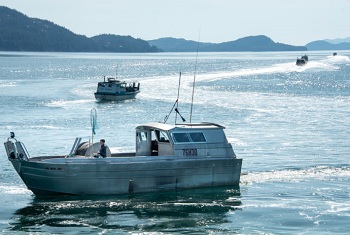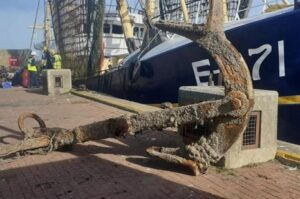Tag Archives: Copper River
Copper River harvest edges slowly towards1.4M
 Harvests of Copper River District salmon edged up slightly to 1.4 million fish as of Tuesday, July 23, while for Prince William Sound overall the catch delivered to processors came to over 7 million fish, as the fishery slowed. Alaska Department of Fish and Game biologist Jeremy Botz in Cordova noted that fishing for coho salmon will pick up in mid-August. Meanwhile, Botz said, the sockeye harvest came in above forecast while the chum and likely Chinook catch would be below forecast. Consumers still hoping to purchase those prized Copper River reds likely won’t find them at their local seafood shops, but via the internet in a wide range of prices, some of which have not declined since the summer salmon season began. more, >>CLICK TO READ<< 11:40
Harvests of Copper River District salmon edged up slightly to 1.4 million fish as of Tuesday, July 23, while for Prince William Sound overall the catch delivered to processors came to over 7 million fish, as the fishery slowed. Alaska Department of Fish and Game biologist Jeremy Botz in Cordova noted that fishing for coho salmon will pick up in mid-August. Meanwhile, Botz said, the sockeye harvest came in above forecast while the chum and likely Chinook catch would be below forecast. Consumers still hoping to purchase those prized Copper River reds likely won’t find them at their local seafood shops, but via the internet in a wide range of prices, some of which have not declined since the summer salmon season began. more, >>CLICK TO READ<< 11:40
Copper River/PWS catch exceeds 1M salmon
 Commercial salmon harvests for the Copper River and the rest of Prince William Sound have now exceeded one million fish, including an estimated 959,946 sockeyes, in a season where retail prices continue to vary from $37.95 to $12.99 a pound. As more commercial fisheries opened statewide, Copper River, Bering River and Coghill district harvesters embarked June 24 on 36-hour commercial drift gillnet openers, and the Eshamy district began a 24-hour fishery. Commercial harvesters in the Unakwik, Montague and Southwestern districts were also fishing. As of late Monday, June 24, the salmon harvest in Prince William Sound stood at 973,000 sockeyes, 549,000 chum, 6,000 Chinook, and 1,000 pinks. Cook Inlet anglers had 42,000 sockeyes, and Bristol Bay districts — which are just getting started — had delivered 228,000 reds, bringing the Central Region total to 1.8 million fish, including 1.2 million sockeyes, 549,000 chum, 6,000 Chinooks, and 1,000 humpies. more, >>CLICK TO READ<< 19:12
Commercial salmon harvests for the Copper River and the rest of Prince William Sound have now exceeded one million fish, including an estimated 959,946 sockeyes, in a season where retail prices continue to vary from $37.95 to $12.99 a pound. As more commercial fisheries opened statewide, Copper River, Bering River and Coghill district harvesters embarked June 24 on 36-hour commercial drift gillnet openers, and the Eshamy district began a 24-hour fishery. Commercial harvesters in the Unakwik, Montague and Southwestern districts were also fishing. As of late Monday, June 24, the salmon harvest in Prince William Sound stood at 973,000 sockeyes, 549,000 chum, 6,000 Chinook, and 1,000 pinks. Cook Inlet anglers had 42,000 sockeyes, and Bristol Bay districts — which are just getting started — had delivered 228,000 reds, bringing the Central Region total to 1.8 million fish, including 1.2 million sockeyes, 549,000 chum, 6,000 Chinooks, and 1,000 humpies. more, >>CLICK TO READ<< 19:12
Copper River continues lead in PWS commercial salmon harvests
 With ice essentially gone from river systems, the sockeyes continued to weigh in heavier than through the same period a year ago, said fisheries biologist Jeremy Botz, in the Cordova office of the Alaska Department of Fish and Game. The Bering River and Coghill districts were also open for 36-hour commercial runs on Monday, and the Eshamy district for a 24-hour period. Montague District opened for purse seiners for 24 hours, and the Southwestern district for 48 hours, also for seiners. Even with other wild Alaska salmon fisheries opening for the season, Copper River sockeyes were holding their own in Anchorage restaurants, with entrees of Copper River reds offered at $49 at Simon and Seafort’s and $32 for the entree at Orso. more, >>CLICK TO READ<< 06:50
With ice essentially gone from river systems, the sockeyes continued to weigh in heavier than through the same period a year ago, said fisheries biologist Jeremy Botz, in the Cordova office of the Alaska Department of Fish and Game. The Bering River and Coghill districts were also open for 36-hour commercial runs on Monday, and the Eshamy district for a 24-hour period. Montague District opened for purse seiners for 24 hours, and the Southwestern district for 48 hours, also for seiners. Even with other wild Alaska salmon fisheries opening for the season, Copper River sockeyes were holding their own in Anchorage restaurants, with entrees of Copper River reds offered at $49 at Simon and Seafort’s and $32 for the entree at Orso. more, >>CLICK TO READ<< 06:50
Area commercial harvest reaches over 438,000 salmon
 When state fisheries biologists shut down the Copper River commercial salmon for two 12-hour openers on June 3 and June 8 retail markets in Anchorage ran out of the popular Copper River fish, making way for the fresh catch of Cook Inlet sockeyes which were selling at $14.99 a pound. The decision to close those fisheries was that river waters were low and very cold, and the migration into rivers was running late, said Alaska Department of Fish and Game fisheries biologist Jeremy Botz, in Cordova. But then ADF&G opted to allow a 12-hour opener on Saturday, June 8, which brought in 338 deliveries with an estimated 74,296 sockeyes, 2,724 chum, 493 Chinook and 434 pink salmon. more, >>CLICK TO READ<< 07:40
When state fisheries biologists shut down the Copper River commercial salmon for two 12-hour openers on June 3 and June 8 retail markets in Anchorage ran out of the popular Copper River fish, making way for the fresh catch of Cook Inlet sockeyes which were selling at $14.99 a pound. The decision to close those fisheries was that river waters were low and very cold, and the migration into rivers was running late, said Alaska Department of Fish and Game fisheries biologist Jeremy Botz, in Cordova. But then ADF&G opted to allow a 12-hour opener on Saturday, June 8, which brought in 338 deliveries with an estimated 74,296 sockeyes, 2,724 chum, 493 Chinook and 434 pink salmon. more, >>CLICK TO READ<< 07:40
Copper River salmon aficionados hail arrival of first fish
 In Cordova the first 12-hour opener of the Copper River commercial salmon fishery, with 376 deliveries, yielded a catch of nearly 43,000 sockeye salmon, 1,108 Chinook, 247 chum, and two cohos to processors. The second opener, with 400 deliveries, brought in another 51,994 sockeye, 1,284 Chinook, 2,182 chum, and 62 coho salmon. As of May 21, the Alaska Department of Fish and Game’s Cordova office said that the overall catch stood at 93,851 sockeye, 2,392 Chinook, 2,433 chum, and 64 coho salmon. Processors were offering $7 a pound for sockeyes and $16 a pound for kings. Meanwhile, a chance to sample the first Copper River sockeye salmon drew some 400 seafood fans to Anchorage ski slopes on Saturday, May 18, where they dined on appetizers prepared by top chefs and bid in an auction that raised $8,350 for the Make A Wish Foundation. more, >>CLICK TO READ<< 14:17
In Cordova the first 12-hour opener of the Copper River commercial salmon fishery, with 376 deliveries, yielded a catch of nearly 43,000 sockeye salmon, 1,108 Chinook, 247 chum, and two cohos to processors. The second opener, with 400 deliveries, brought in another 51,994 sockeye, 1,284 Chinook, 2,182 chum, and 62 coho salmon. As of May 21, the Alaska Department of Fish and Game’s Cordova office said that the overall catch stood at 93,851 sockeye, 2,392 Chinook, 2,433 chum, and 64 coho salmon. Processors were offering $7 a pound for sockeyes and $16 a pound for kings. Meanwhile, a chance to sample the first Copper River sockeye salmon drew some 400 seafood fans to Anchorage ski slopes on Saturday, May 18, where they dined on appetizers prepared by top chefs and bid in an auction that raised $8,350 for the Make A Wish Foundation. more, >>CLICK TO READ<< 14:17

Disaster aid has arrived, but Western Alaska’s salmon and crab problems continue
The Alaska congressional delegation announced on Friday that the U.S. Commerce Department released the disaster aid. The money is to go to harvesters, processors and communities affected by designated disasters in salmon and crab fisheries that occurred between 2020 and 2022. For Bering Sea snow crab, signs are that the problems that led to the first-ever harvest closure, which was announced last October, will last for years. The National Oceanic and Atmospheric Administration Fisheries Service 2022 survey found that despite the emergence of cooler and more normal temperatures, mature male snow crab abundance was the lowest on record and mature female snow crab abundance was the third lowest on record. >click to read< 10:12

Fit for a king: First Copper River king salmon of season arrives in Anchorage
It all started with a kiss and, well, kind of ended with a kiss: The first fish were alive just 24 hours before it arrived at Ted Stevens Anchorage International Airport. “First fresh salmon coming out of the state ahead of Bristol Bay,” said Jeff Munro, a cargo operations manager. “The Copper River salmon is a real special salmon. It’s a special breed and species. It has a higher oil content.” Box after box of fresh fish came off the jet in Anchorage Tuesday afternoon. The first one got a special trip down a red carpet laid out for all to see. “Copper River salmon really marks the beginning of Alaska’s summer salmon season,” said Cassandra Squibb with Copper River Seafoods. Video, >click to read< 07:59

Alaska Department of Fish and Game forecasts fair to poor sockeye runs for Cook Inlet, Copper River
State biologists are projecting a mixed bag of returns this spring and summer for Southcentral’s popular sockeye salmon fisheries. Alaska Department of Fish and Game officials on Feb. 7 issued a forecast estimating that just less than 5 million sockeye will return to upper Cook Inlet river systems, allowing for a harvest of nearly 3 million sockeye from the region overall. It’s expected approximately 2.9 million fish from the total run will be headed to the Kenai, with another 941,000 pegged for the nearby Kasilof. >click to read< 19:19
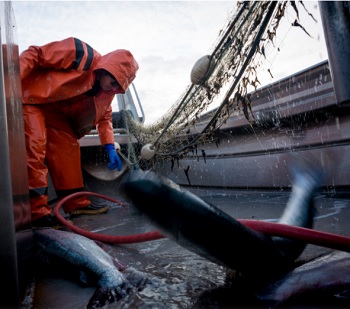
Seine season brings ‘bright light’ to struggling fleet
In a year when the fishery was shut down for 16 days, inflicting economic pain on gillnetters, the seine season proved a bright light overall for commercial salmon harvesters, “Many of us were nervous after the 2019 drought and uncertainties with what that meant for returns in 2021,” “It’s heartbreaking to see our community continue to struggle, to know it’s impacting families, our city’s fish tax revenue, and ultimately the city and school budget.” >click to read< 20:09

The big bust
The 2020 decline in North Pacific salmon numbers appears to have been the greatest in recorded history, according to a trio of scientists who’ve spent much of their careers studying the secret lives of salmon in the ocean. They suggested to the North Pacific Anadromous Fish Commission (NPAFC), an international monitoring group, that the crash was likely driven by warmer ocean waters and an explosion of pink salmon in 2018 and 2019.,, “Unexpectedly, the high abundance of Pacific salmon came to an abrupt end in 2020. Preliminary commercial catch statistics for all salmon species indicate Pacific salmon harvests, which provide an index of abundance, declined more in 2020 than in any other period on record since 1930. >click to read< 11:01

Copper River set for 24-hour opener on June 28
Commercial fishing on the Copper River begins an eighth opener on Monday, June 28, for a 24-hour drift gillnet fishery. The announcement on Saturday, June 26, from the Alaska Department of Fish and Game’s Cordova office,,, All the Monday openers begin at 8 a.m.,, Preliminary harvest estimates for Prince William Sound, including the Copper River, as of Saturday, June 26, included 7,548 Chinook, 333,667 sockeye, 489 coho, 588,533 chum and 2,166 pink salmon. >click to read< 08:40

“We’ve been sitting on the beach for 16 days” – Copper River salmon fishery reopens
“We are back to getting into the goal range,” said Jeremy Botz, finfish area management biologist for the Alaska Department of Fish and Game in Cordova. “I think we are seeing a late compressed run. I still feel it is a relatively small run, but higher than in 2018 and 2020.”,, While eager to be fishing again, veteran Cordova harvesters felt they should have been allowed out on the grounds earlier to get a better handle on what the run, albeit late and maybe compressed, was really stacking up to be.,, Cordova harvester John Renner said the fleet should have been used earlier to collect data, to see if the run was weak or strong, rather than just waiting for the sonar count. “We’ve been sitting on the beach for 16 days,” >click to read< 14:15
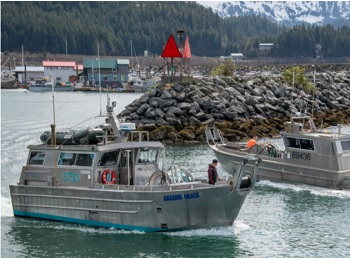
Copper River District: As stocks decline, veteran harvesters want more answers, better enforcement of regulations
The harvest for the three openers to date totaled an estimated 60,127 fish, including 5,259 Chinook, 52,752 sockeye and 2,116 chum. All this comes as little surprise to veteran fishermen like Bill Webber, now in his 54th year as a commercial harvester. Why the run of the oil rich Copper River sockeyes and Chinooks has been so troubled in recent years has prompted a lot of speculation. The situation has a lot of fishermen in the Cordova area pondering what possible role Northern Edge military exercises in the Gulf of Alaska, climate change and other fishermen upriver, particularly near spawning grounds, are playing. >click to read< 10:55

Copper River closed again amid low counts
This year’s Copper River sockeye run is starting out a lot like last year’s, which is bad news for most everyone, except for maybe the fish that are showing up. Alaska Department of Fish and Game managers closed the famed early season drift gillnet fishery for a second consecutive opener May 31 due to poor sockeye counts at the department’s Miles Lake sonar upriver from the fishery. Just 54,154 sockeye had been counted at Miles Lake through May 31, compared to the approximately 132,000 fish needed by that date to meet the department’s,, >click to read< 08:58

Copper River wild salmon fishery off to a slow start
Drift gillnetters out on the first Copper River opener of the 2021 wild salmon fishery harvested an estimated 1,957 Chinook, 8,197 sockeye and 173 chum salmon, and within 24 hours much of the catch was delivered to Seattle via Alaska Airline’s “Salmon-Thirty-Salmon” jet. Airline officials said the first flight brought in 17,000 pounds of wild Alaska king and red salmon headed for markets in Seattle, Dallas-Fort Worth, Los Angeles, San Francisco and Chicago. When the jet, painted to look like a gigantic king salmon, arrived at SeaTac, Alaska Airlines Captain Tim deal, with First Officer Bill Jacobson, held up a sample of the catch, a 37-pound Chinook salmon. >click to read< 13:05

The world’s finest salmon season is now under way
Today officially inaugurates Alaska’s summer salmon season with the opening of the first Copper River salmon fishing period of the 2021 season. Beginning at 7 am, the Copper River fishing fleet, comprised of 540 small-boat, independent commercial fishing permit holders will have the opportunity to harvest highly-prized Copper River king and sockeye salmon during a short 12-hour window. Today’s catch will be delivered to Cordova’s shore-based seafood processors and flown fresh to companies and individuals across the country who have reserved exclusive rights to the season’s first fish. >click to read< 21:19

Alaska and B.C.’s salmon runs expected to be worst ever recorded
Salmon returns on the west coast look bleak this year. Alaska’s salmon returns have been so poor that some communities already are claiming fishery disasters. The socket salmon run on B.C.’s Fraser River is expected to be the worst ever recorded,, in Alaska, the Cordova City Council passed a resolution last week, asking the state to declare disasters for both the 2018 Copper River sockeye and chinook salmon runs and the 2020 sockeye, chum and chinook runs at the Copper River and Prince William Sound,, The Pacific Salmon Commission (PSC) says this year may turn out to be the worst for sockeye salmon in the Fraser River since tracking began in 1893, >click to read< 12:56

Salmon harvest coming in below forecast
Commercial harvests of Alaska’s iconic salmon are generally below expectation so far this season, particularly in the Copper River, where the preliminary catch to date includes 81,228 reds, 5,815 Chinooks and 1,296 chums. And overall for the drift gillnet harvesters and purse seiners in Prince William Sound, so far it is a smaller run that forecast, with a preliminary collective harvest of some 736,453 fish. That’s according to statewide data compiled by biologists with the Alaska Department of Fish and Game, who update their preliminary harvest report daily and post. >click to read< 09:42
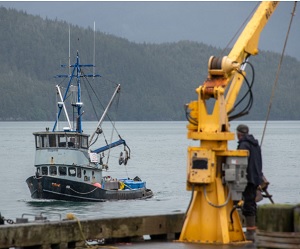
Copper River fishermen gain another harvest
Commercial harvesters keen on those Copper River salmon got a fifth shot at those prized Chinooks and reds on Thursday, June 18, in a 12-hour opener announced by Alaska Department of Fish and Game officials in Cordova. Waters within the expanded Chinook salmon inside closure area were closed for the period. It has been, in no uncertain terms a real slow start, with several of those openers already cancelled because of a very slow run. Through Tuesday, June 16, a total of 1,665 deliveries to processors from four 12-hour openers in the Copper River had brought in some 5,751 kings, 71,370 sockeyes and 1,056 chums, a total of 78,177 fish. >click to read< 16:01
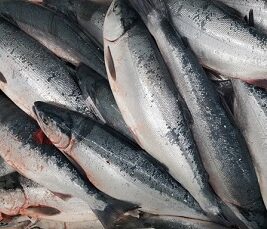
It aint looking good – Low prices, weak run hammer Copper River fishermen
Fishermen headed into the 2020 season knew it would be different, but in the weeks since the Copper River District opened on March 14, low prices and a weak run has dealt a one-two punch to fishermen. “The 2020 gillnet season for the Copper River and Prince William Sound is definitely the worst one I’ve experienced so far,” Mike Mickelson, a Cordova based fisherman, said. “The managers just have us closed for the Copper River fishery because they’re worried about getting escapement, >click to read< 10:33

After cancellation of the third Copper River period, ADF&G okayed a 12-hour opener on Memorial Day
Light winds, fog and rain spread over Prince William Sound as veteran harvester Bill Webber headed out to sea on the eve of the Memorial Day opener for the famed Copper River wild salmon fishery, hoping perhaps that the third time’s the charm. The third time, that is, because the first opener on May 14, and the second opener on May 18 proved so below the forecast that Alaska Department of Fish and Game biologists halted the anticipated third opener on May 21, then decided on May 22 to go ahead with a third 12-hour opener on Monday, May 25. “The wind isn’t bad, maybe 15 miles an hour, a little foggy, a little rainy,” said Webber, owner of direct-to-consumer Paradigm Seafoods, from the helm of his boat, >click to read< 10:57

Still slow going for Copper River opener, remains closed at least through Monday, May 25
Opening harvests of the 2020 Copper River commercial fishery, complicated by effort to keep the COVID-19 pandemic at bay, got off to a slow start for the first two 12-hour openers. The overall catch of Chinook and sockeye salmon came in way below forecast. The first two 12-hour periods brought processors an estimated 6,025 sockeyes and 3,255 king salmon, Copper River commercial fishery biologists said. The 372 deliveries from the first opener on May 14 included just 1,473 sockeyes and 1,552 Chinooks. Then on May 18, there were 412 deliveries, with 4,552 sockeyes and 1,703 Chinooks. The projected harvest for the second period alone had included 28,590 reds. >click to read< 16:16

With coronavirus pandemic procedures in place, Copper River salmon season ready to open
Hundreds of vessels and workers flood into Prince William Sound each May for a chance to harvest the first fresh wild king salmon of the year, followed by the famous Copper River sockeye and the broader Prince William Sound pink salmon fisheries. However, with limited road access and health care facilities, city and state officials have been coordinating with the fleet and stakeholders about how to safely allow in deckhands, captains, and processing workers from Outside without inviting the pandemic to Cordova as well. “Fishermen are very concerned and have been concerned since day one,” said Francis Leach, the executive director of the United Fishermen of Alaska. “Now that procedures have been put in place, there are a lot of questions. It’s always a learning curve. Folks are really going to have to pay attention to (the mandate).” >click to read< 14:36
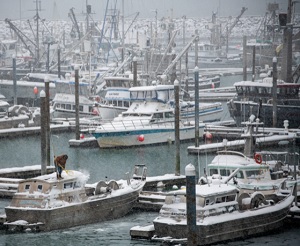
Humpy run into Price William Sound forecast is above average
Forecasts for the 2020 fishing season show a robust run of pink and chum salmon into Price William Sound, along with a healthy run of kings and below average return of wild and hatchery salmon to the Copper River. The area forecast released by the Alaska Department of Fish and Game on Tuesday, Jan. 28, also put wild sockeye returns to Coghill Lake at slightly below average. >click to read< 09:20

Harvest numbers are mixed as season gets underway. Meanwhile, PWS wild salmon harvest tops 1.5M fish
Prince William Sound landings of wild Alaska salmon have been strong, as the fishery gets under way. Meanwhile sockeye production in Kodiak, Cook Inlet and Chignik is off to a slow start, fisheries economist Garrett Evridge says in his first harvest report of the season. “Year-to-date statewide harvest of sockeye is more than three times the prior year,” said Evridge, an economist with the McDowell Group, >click to read<14:08
PWS wild salmon harvest tops 1.5M fish – As more areas of Prince William Sound opened for commercial fishing, preliminary data compiled by the Alaska Department of Fish and Game put the catch at 1.5 million salmon through June 18, including some 813,942 fish caught in the Copper River. >click to read<

Copper River harvest hits 429,630 fish and rising
That sixth opener was the charm, “a very welcome relief for this fleet,” said drift gillnet harvester John Renner. “It appears to be a larger run than predicted,” said Renner, in a phone call from his Cordova home on Wednesday, June 5, in the wake of the 36-hour opener of the 2019 Copper River commercial salmon season, which ended at 7 p.m. the previous evening. “The fish are also large and healthy, indicating a larger component of older fish,” Renner said. “They are spread out across the flats offshore and onshore. “ >click to read<10:56

Copper River sockeye show up early, give optimism for fleet
Copper River fishermen are getting a nice change of pace from the last two years this season as the sockeye run is shaping up better than expected so far. As of June 2, approximately 240,234 sockeye salmon had passed the sonar at Miles Lake on the Copper River, according to the Alaska Department of Fish and Game. That’s about 65,000 more fish than the cumulative management objective so far on the river, which is based on average past escapements. It’s definitely better than in 2017 and 2018, when slow and weak sockeye runs kept commercial fishermen at the docks as managers struggled to make escapements. On the same date in 2018, only 55,840 sockeye had passed the sonar. (click to read)14:39

The mysterious case of Alaska’s strange sockeye salmon returns this year
There’s something unusual going on with the sockeye salmon runs returning to Alaska this year. In some places — like Bristol Bay — the runs are strong. In others, like the Copper River or the Kenai River they’re unexpectedly weak. In some places, there are sockeye that are unusually small. In others, sockeye of a certain age appear to be missing entirely. It’s a mystery. In Southeast Alaska, one of the first Fish and Game staffers to notice an unusual trend was Iris Frank, a regional data coordinator and fisheries technician. Frank’s lab is on the first floor of Fish and Game’s Douglas Island office that looks like it hasn’t changed much in the 32 years since she got there. >click to read<18:06

Copper disaster
No sooner did the burst of sockeye salmon into the Copper River begin than it was over. With the famous salmon river in eastern Alaska again falling behind projected daily returns, the Alaska Department of Fish and Game announced today that a Thursday through Sunday opening of the popular personal-use dipnet fishery will likely be the year’s last. The weak sockeye run has now turned into a disaster for almost everyone. Cordova commercial fishermen off the mouth of the river caught only 26,000 of the highly valuable sockeye in three short openings in May before they were shutdown for the year. >click to read<20:33






